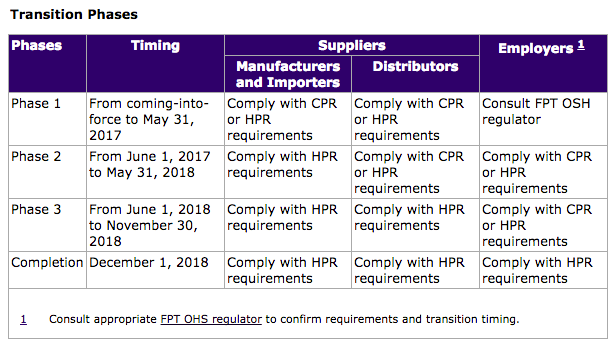GHS Compliance Dates
Did you know that approximately 72 countries have already implemented- or are in the process of implementing, the Globally Harmonized System of Classification and Labelling of Chemicals into their existing labor legislations? The idea of a universally compatible classification and communication systems for chemical products was initially brought up in the 1992 United Nations Conference on Environment and Development (UNCED, 1992) with the 2002 release of its 1st published draft of regulations, ‘The First Edition of GHS (GHS Rev.1).’ The biennial updating of GHS has lead to release of The 6th Revised Edition of GHS (GHS Rev.6) which even further ensures that the system is ready for world-wide implementation.
GHS compliance dates are quite variable across the many different countries who are still in the progress of transitioning into a GHS compatible system. The United States is the first of Northern American nations to have fully implemented the GHS system into their labour legislation. Under guidance from America’s Occupational Safety and Health Administration, the GHS-aligned modifications to their Hazard Communication Standards (HCS) program occurred via a 3-phase, transitional process that came to completion on June 1st, 2016. Upon initial introduction of the HCS 2012 program, a time-line of GHS-compliance dates was released in which chemical manufacturers, importers, distributors, and employers were expected to meet the set deadlines. Canada similarly followed suite, given America’s success in implementing GHS via a phased-in transition.
Canada enacts its labor laws through the federally regulated, Hazardous Products Act (HPA), and Hazardous Products Regulations (HPR), amendments. Provinces and territories, then enforce these regulations in alignment with the Occupational Health and Safety Acts of their independent jurisdiction. Provinces and territories must be synchronized in how they meet the GHS compliance dates; a 3-stage, multi-transitional time-frame for national implementation will allow independent jurisdictions to adjust their legislations in compliance with WHMIS 2015. Enactment of WHMIS 2015 via a 3-stage transition period follows closely to HCS 2012’s phased-in transition, in the United States; trading partners and stakeholders are given time to adjudicate their systems according to the new regulations, time is given to workers and employers such that they can increase their understanding and awareness of the GHS-aligned hazard communication system, and finally the use of WHMIS 1988 labels and MSDS’S can be gradually phased out of workplaces. The GHS compliance dates for Canada are outlined in the table below taken from the Health Canada website.
Mexico, the last of 3 main Northern American nations, only recently released the ‘Harmonized System for the Identification and Communication of Hazards and Risks of Hazardous Chemicals in the Workplace’ (NOM-018-STPS-2015), an amendment entailing new GHS-aligned standards (based on 5threvised edition of GHS) to be implemented in the workplace. Once again, certain requirements are to fulfilled in alignment with their GHS compliance dates; this 3-year, transitional time-line will commence on October 2018 in which compliance with the new standards are mandatory. Adoption of GHS amongst these 3 neighbors will simplify chemical trade between these nations and further increase the protection of workers due to GHS-harmonization of information presented on hazardous products. Several other countries are approaching or have already approached their final GHS compliance dates including Japan, Singapore, Thailand, Argentina, Vietnam, the Philippines, and the EU.

